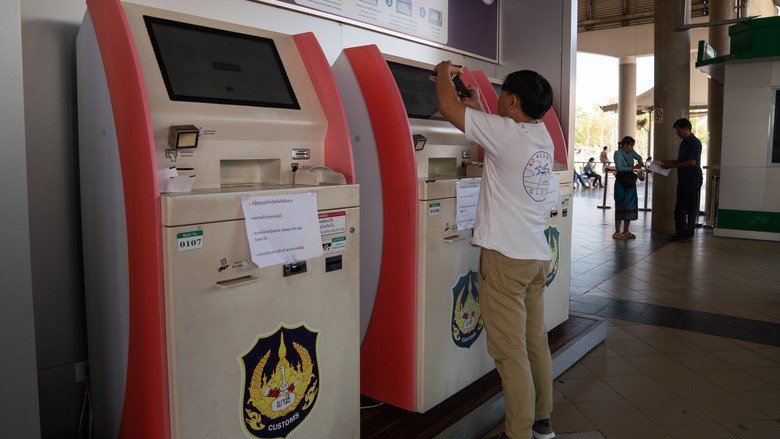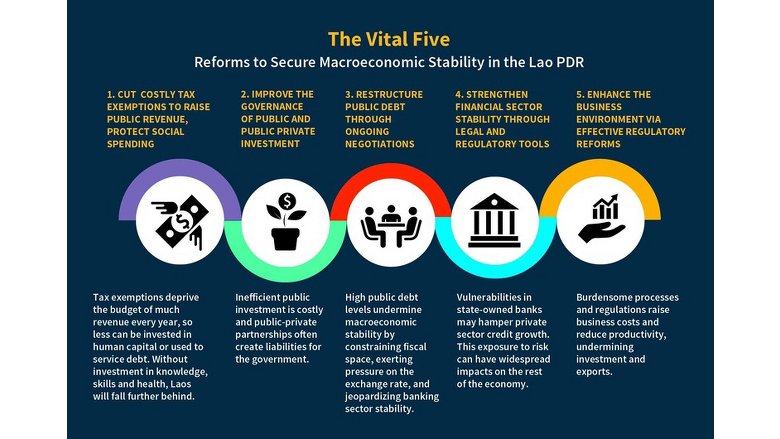? The kip continues to depreciate, falling in value by 29% against the Thai baht and 21% against the US dollar in the year to October 2023. With banks rationing access to foreign currency at official rates, the difference between official and parallel market exchange rates has risen to about 15% for the dollar and 8% for the baht. The main factor in the kipˇŻs falling value has been the lack of foreign currency available in country, a result of the need to repay large external debts, despite some deferrals, and limited capital inflows. Monetary policies and exchange rate measures have had only a temporary impact on official and parallel market exchange rates, suggesting that they are not fixing the root causes of kip depreciation.
? On average, a 1% fall in the value of the kip increases consumer prices by 0.5%. Therefore, inflation will remain high until exchange rates stabilize. While the global prices of some imported goods have eased, inflation remains high in Laos, reaching 26% in the year to October 2023. Food price inflation stood at 29%, severely affecting poor urban households.
? Real household incomes have suffered from rising living costs. In a World Bank survey conducted in June 2023, 54% of interviewed households said their income had remained stable or declined. While inflation reached 39% percent in the year to May 2023, the average nominal wage grew by only 5.7%, meaning inflation-adjusted wages dropped by an average of 33%. Households are coping by producing or foraging more food, reducing how much they eat, and migrating to Thailand in search of better-paid jobs. Half of the respondents now spend less on health and education. As public expenditure in these sectors is also falling, LaosˇŻ overall investment in human capital is declining, which will affect medium-term economic growth prospects.
? The government has taken measures to improve its finances by controlling expenditure and increasing domestic revenues in the first half of 2023. Higher economic activity and price increases have offset reduced VAT and fuel excise rates. To further boost revenues, excise rates have recently been raised on vehicles, alcohol, and tobacco. While the government earned more than it spent in the first half of 2023, high debt repayments mean fiscal space is still limited, constraining investment in human capital. Combined public spending on education and health has declined from 4.9% of GDP in 2013 to an estimated 2.3% in 2023.
? Public and publicly guaranteed (PPG) debt is undermining macroeconomic stability and development prospects. Laos faces solvency and liquidity challenges due to significant financing needs, limited financing options, low foreign exchange reserves, and considerable depreciation pressures. The PPG debt stock reached 112% of GDP at the end of 2022, although that value rises to 125% of GDP if expenditure arrears and a swap arrangement are included. The energy sector, primarily through EDL, accounted for about 48% of external PPG debt in 2022. About half of the debt stock in 2022 and half of external debt repayments scheduled for 2024¨C27 is owed to China. Deferrals of debt payments due to China amounted to about $2 billion between 2020-23, providing some temporary relief. However, a high degree of uncertainty surrounds future repayment plans, so a successful conclusion to ongoing debt renegotiations will be crucial to restoring macroeconomic stability.
? Assuming that Laos resumes making debt repayments on schedule, economic growth is projected to accelerate to an average of 4.2% in the medium term, led by the services sector and exports. Growing international demand, coupled with LaosˇŻ improving connectivity and logistics services, is expected to help manufacturing and agriculture exports. Industry may also benefit from investment in the power sector and special economic zones. However, structural weaknesses will limit growth. The kip is likely to remain under pressure because of high imports and large debt repayments due. Inflation will therefore remain in double-digits in 2024. With high living costs, household incomes will improve only gradually, and slow progress in poverty reduction will likely continue.
? External imbalances are expected to persist, undermining exchange rate stability. The current account deficit is expected to remain at around 3-4% of GDP as improvements in merchandise exports, tourism, and remittances are offset by higher imports and interest payments on debt.
? The economic outlook is subject to significant uncertainty. The main external risks include low global and regional growth, which would lower demand for Lao exports. Escalating global tensions could raise commodity prices, which would in turn increase domestic inflation. Domestic risks include further loss of foreign currency because of debt service obligations, slow progress with structural reforms, and a deterioration of bank balance sheets. Labor shortages due to out-migration can undermine the recovery prospects of labor-intensive sectors, including agriculture, manufacturing, and services. Climate shocks could also hamper economic recovery.



